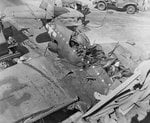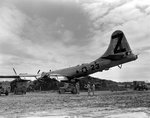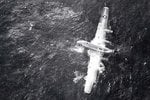According to the AAF Statistical Digest, in less than four years (December 1941- August 1945), the US Army Air Forces lost 14,903 pilots, aircrew and assorted personnel plus 13,873 airplanes --- inside the continental United States. They were the result of 52,651 aircraft accidents (6,039 involving fatalities) in 45 months. Almost 1,000 Army planes disappeared en route from the US to foreign climes. But an eye-watering 43,581 aircraft were lost overseas including 22,948 on combat missions (18,418 against the Western Axis) and 20,633 attributed to non-combat causes overseas. In a single 376 plane raid in August 1943, 60 B-17s were shot down. That was a 16 percent loss rate and meant 600 empty bunks in England. In 1942-43 it was statistically impossible for bomber crews to complete a 25-mission tour in Europe. Pacific theatre losses were far less (4,530 in combat) owing to smaller forces committed. The worst B-29 mission, against Tokyo on May 25, 1945, cost 26 Superfortresses, 5.6 percent of the 464 dispatched from the Marianas.
On average, 6,600 American servicemen died per month during WWII, about 220 a day. By the end of the war, over 40,000 airmen were killed in combat theatres and another 18,000 wounded. Some 12,000 missing men were declared dead, including a number "liberated" by the Soviets but never returned. More than 41,000 were captured, half of the 5,400 held by the Japanese died in captivity, compared with one-tenth in German hands. Total combat casualties were pegged at 121,867. US manpower made up the deficit. The AAF's peak strength was reached in 1944 with 2,372,000 personnel, nearly twice the previous year's figure. The losses were huge---but so were production totals. From 1941 through 1945, American industry delivered more than 276,000 military aircraft. That number was enough not only for US Army, Navy and Marine Corps, but for allies as diverse as Britain , Australia , China and Russia. In fact, from 1943 onward, America produced more planes than Britain and Russia combined. And more than Germany and Japan together 1941-45. However, the Axis took massive losses. Through much of 1944, the Luftwaffe sustained uncontrolled hemorrhaging, reaching 25 percent of aircrews and 40 planes a month. And in late 1944 into 1945, nearly half the pilots in Japanese squadrons had flown fewer than 200 hours. The disparity of two years before had been completely reversed.
Source: An Airman's Story - Blog, News, & Informations - An Airman's Story
In general, the loss rates fluctuated according to developments, such as when older types were being decimated, then phased out, and new types were brought in. As the strategic offensive grew, losses increased as the more heavily defended and more distant targets were attacked. Tactical and electronic measures and countermeasures also caused the numbers to fall and then rise again. For example, the literature describes an improvement in the loss rate but then came a realization of a significant increase with the advent of Schrage musik but it was only identified later as the cause. Even in the later period, as the Luftwaffe started to pull back, loss rates could suddenly spike up. The rates fluctuated between double-digit percentages to less than one per cent throughout the war.
Numbers:
China: Total losses of the Nationalist Air Force were 2,468 (According to Chinese and Taiwanese Sources).
Finland: Reported losses during the Winter War totaled 67, of which 42 were operational, while 536 aircraft were lost during the Continuation War, of which 209 were operational losses. (Overall 603).
France: From the beginning of the war until the capitulation of France in 1940, 892 aircraft were lost, of which 413 were in action and 234 were on the ground. Losses included 508 fighters and 218 bombers.(Overall 892)
Germany: Estimated total number of destroyed and damaged for the war totaled 116,875 aircraft, of which 70,000 were total losses and the remainder significantly damaged. By type, losses totaled 41,452 fighters, 22,037 bombers, 15,428 trainers, 10,221 twin-engine fighters, 5,548 ground attack, 6,733 reconnaissance, and 6,141 transports.
Italy: Total losses were 5,272 aircraft, of which 3,269 were lost in combat.
Japan: Estimates vary from 35,000 to 50,000 total losses, with about 20,000 lost operationally.
Netherlands: Total losses were 81 aircraft during the May, 1940 campaign.
Poland: Total losses were 398 destroyed, including 116 fighters, 112 dive bombers, 81 reconnaissance aircraft, 36 bombers, 21 sea planes, and 9 transports.
Soviet Union: Total losses were over 106,400 including 88,300 combat types.
United Kingdom: Total losses in Europe were 22,010, including 10,045 fighters and 11,965 bombers. (This figure does not include aircraft lost in Asia or the Pacific.)
United States: Total losses were nearly 45,000, including 22,951 operational losses (18,418 in Europe and 4,533 in the Pacific).
Source: Equipment losses in World War II - Wikipedia, the free encyclopedia
On average, 6,600 American servicemen died per month during WWII, about 220 a day. By the end of the war, over 40,000 airmen were killed in combat theatres and another 18,000 wounded. Some 12,000 missing men were declared dead, including a number "liberated" by the Soviets but never returned. More than 41,000 were captured, half of the 5,400 held by the Japanese died in captivity, compared with one-tenth in German hands. Total combat casualties were pegged at 121,867. US manpower made up the deficit. The AAF's peak strength was reached in 1944 with 2,372,000 personnel, nearly twice the previous year's figure. The losses were huge---but so were production totals. From 1941 through 1945, American industry delivered more than 276,000 military aircraft. That number was enough not only for US Army, Navy and Marine Corps, but for allies as diverse as Britain , Australia , China and Russia. In fact, from 1943 onward, America produced more planes than Britain and Russia combined. And more than Germany and Japan together 1941-45. However, the Axis took massive losses. Through much of 1944, the Luftwaffe sustained uncontrolled hemorrhaging, reaching 25 percent of aircrews and 40 planes a month. And in late 1944 into 1945, nearly half the pilots in Japanese squadrons had flown fewer than 200 hours. The disparity of two years before had been completely reversed.
Source: An Airman's Story - Blog, News, & Informations - An Airman's Story
In general, the loss rates fluctuated according to developments, such as when older types were being decimated, then phased out, and new types were brought in. As the strategic offensive grew, losses increased as the more heavily defended and more distant targets were attacked. Tactical and electronic measures and countermeasures also caused the numbers to fall and then rise again. For example, the literature describes an improvement in the loss rate but then came a realization of a significant increase with the advent of Schrage musik but it was only identified later as the cause. Even in the later period, as the Luftwaffe started to pull back, loss rates could suddenly spike up. The rates fluctuated between double-digit percentages to less than one per cent throughout the war.
Numbers:
China: Total losses of the Nationalist Air Force were 2,468 (According to Chinese and Taiwanese Sources).
Finland: Reported losses during the Winter War totaled 67, of which 42 were operational, while 536 aircraft were lost during the Continuation War, of which 209 were operational losses. (Overall 603).
France: From the beginning of the war until the capitulation of France in 1940, 892 aircraft were lost, of which 413 were in action and 234 were on the ground. Losses included 508 fighters and 218 bombers.(Overall 892)
Germany: Estimated total number of destroyed and damaged for the war totaled 116,875 aircraft, of which 70,000 were total losses and the remainder significantly damaged. By type, losses totaled 41,452 fighters, 22,037 bombers, 15,428 trainers, 10,221 twin-engine fighters, 5,548 ground attack, 6,733 reconnaissance, and 6,141 transports.
Italy: Total losses were 5,272 aircraft, of which 3,269 were lost in combat.
Japan: Estimates vary from 35,000 to 50,000 total losses, with about 20,000 lost operationally.
Netherlands: Total losses were 81 aircraft during the May, 1940 campaign.
Poland: Total losses were 398 destroyed, including 116 fighters, 112 dive bombers, 81 reconnaissance aircraft, 36 bombers, 21 sea planes, and 9 transports.
Soviet Union: Total losses were over 106,400 including 88,300 combat types.
United Kingdom: Total losses in Europe were 22,010, including 10,045 fighters and 11,965 bombers. (This figure does not include aircraft lost in Asia or the Pacific.)
United States: Total losses were nearly 45,000, including 22,951 operational losses (18,418 in Europe and 4,533 in the Pacific).
Source: Equipment losses in World War II - Wikipedia, the free encyclopedia




















































